Short Scope Continued - Crash Test
14/02/15 23:48
By Paul Shard, Copyright 2015. All rights reserved.
Testing continues... In this case we are anchored in 12.5 meters of water (plus 1.5 meters to the bow) for a total of 14 meters bow-to-bottom. We have our Rocna 33kg anchor (73 pounds) plus 45 meters of rode... 45 / 14 = 3.2:1 scope...
We wonder just how much force the anchor will get if we load it right up with this short scope. With our previous tests we believe our engine will simulate 30 knots of wind - but what about stronger gusts or lulls that allow the boat to build up momentum and jerk back harder? We decide to simulate this by jerking back on the anchor from a position somewhat forward then putting the engine in hard reverse. Sheryl will be on board and running the engine. This is not a precise test since the speed we attain in reverse will vary with each test. But it will make much greater forces than just running slowly up to full throttle astern. Sheryl will also try to estimate how this approximates to forces we have felt on the boat in violent squalls at anchor.
We are anchored and the boat resting - chain hanging down - as Sheryl puts the engine in full astern. We develop some sternway and momentum before the chain comes up taut, bouncing our 36,000 lbs of boat back forward. The force on the boat is quite impressive - Sheryl describes it: “The bow immediately snapped around to line up with the anchor and then the bow got pulled down from the force on the chain due to the anchor holding so well. It felt like when gusts of 40-50 knots whip the bow around”.
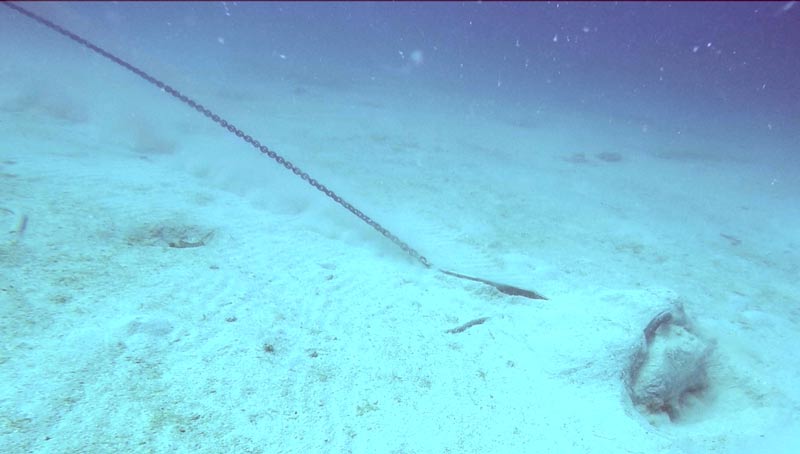
Underwater I watch the chain lift up off the bottom. It is coming up at an angle that actually raises the shank a little. The anchor moves about 12 inches back and digs in deeper. I wonder if this would have been the same with our old CQR Anchor? It might have possibly pulled out and dragged - but the 73 lb Rocna held on well.
Now Sheryl extends our scope to 52 meters - 52/14 = 3.7:1 so we are still less than 4:1 scope. We retest with a similar full power fast reverse and the bow snaps around again. The extra scope makes a big difference here as the shank doesn’t quite come up off the bottom. The anchor barely moves this time.
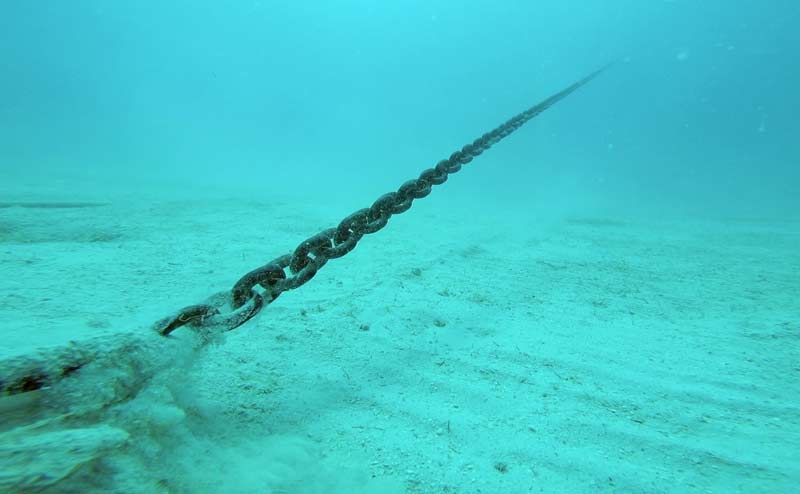
Conclusions on Deep Water Anchoring
In normal conditions (not storm force forecast) an all chain rode will allow reduced scope in deep anchorages. We find 3:1 scope to be OK for anchoring in 50 feet of water. Increasing scope to 4:1 or 5:1 will be better and would be a good idea if strong squalls were forecast. Even an increase to 3:5:1 will make the anchor more effective.

Join our email list and get hints, technical articles and tips plus videos to help you achieve your cruising dreams.
- FREE 1/2 hour video on cruising the Exuma Islands in the Bahamas
- Technical Blog shows you how to deal with issues facing the cruising sailor
- Destination information from some of the world's best cruising areas
- Special discounts and promotions
Anchoring Sample from Lets Go Cruising
Comments
Short Scope Anchoring in Deep Water
07/02/15 13:43
By Paul Shard, Copyright 2015. All rights reserved.
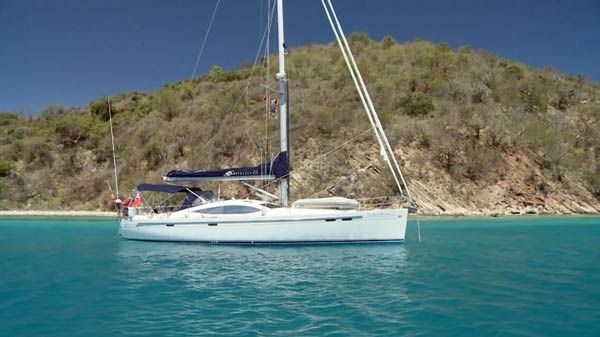
Do you ever wonder how to anchor in a crowded anchorage when the water is a bit deeper than you are used to?
Do you sometimes come into a busy anchorage and can’t to find a place to anchor where you can put out the recommended 5:1 scope?
Or do you sometimes arrive at an anchorage that is deeper than you’re used to and wonder if you have enough rode to lay out a 5:1 scope?
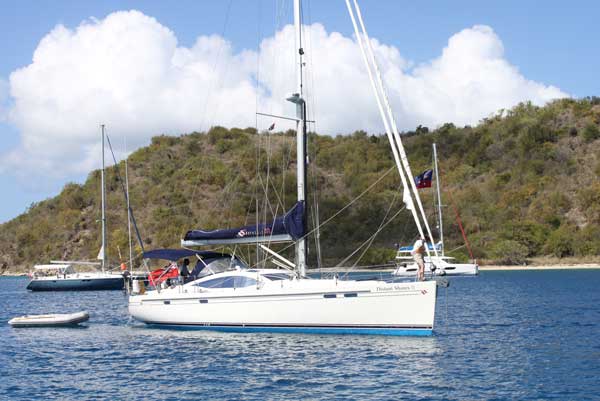
Welcome to the world of “short scope” deep water anchoring…
In deep anchorages that are either small or crowded Sheryl and I occasionally need to anchor with shorter scope than we would like to. In these situations we have used as little as 3:1 scope. The question is “how bad is this really?” Are there situations where you don’t really need to have the recommended 5:1 scope?
Standard “rules” say we need 5:1 scope and this is a good generalization for regular anchoring with an all-chain rode. But it doesn’t take into account the effect of having all that weight down when you have laid out a lot of chain in deep water.
If we put out 165 feet of our 3/8” chain, we have got 250 pounds of weight in chain between our anchor and the bow of our boat. This forms a curve called a catenary curve - the weight of the chain pulling down the rode even when the wind is blowing strongly. So the chain near the anchor will hopefully be pulling close along the bottom - not lifting the anchor up. But just what is the effect of this and how much can we count on it to hold the boat in place? How much of a difference will it be to having the same scope in shallower water?
Test Anchoring in Deep Water
In our test anchorage the wind is blowing 15-20 knots with gusty conditions and it is a busy but not exactly crowded anchorage. It’s deeper than normal - about 50 feet deep with a nice sandy bottom where we are anchoring. Our Rocna 33 anchor weighs 73 pounds. We have 275 feet of 3/8 G4 (G40) chain.
Water is 50 feet deep + 5 feet to the bow roller. Here is how much chain we will need to achieve different scope ratios...
5:1 Ratio 55 feet X 5 = 275 feet
4:1 Ratio 55 feet X 4 = 220 feet
3:1 Ratio 55 feet X 3 = 165 feet
The problem is that nearby boats would make it hard to find a place to lay out all our 275 feet of chain (which is the total of what we carry)
So we set out 165 feet of chain and pull back to set the anchor. This means we have a scope of just 3:1.
I calculate our Yanmar 54 hp engine with Autoprop 3 blade propellor will develop about 400-500kg of pull (1000 pounds) at full power. This is roughly equal to the force on the anchor in a gale 30-40 knots. So we are simulating a similar stress on the anchor as we are likely to experience in normal conditions if the forecast shows 20 knots and a rain squall comes through …
My goal with this setup was to dive down and see what the anchor looked like in these conditions. Would the rode be lifting up off the bottom or would the weight of the chain be holding it down on the sand?
Here are pictures from our test - engine astern at 2500 rpm simulating winds over 30 knots.
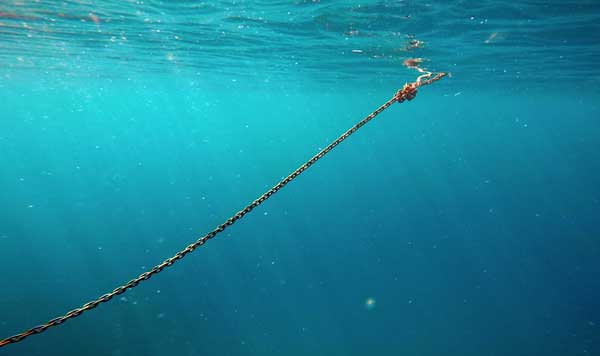
Although the chain enters the water at a steep angle this is the effect of the 250 pounds of chain. This is the effect of the catenary - the weight of the chain makes the 3:1 scope pull pretty much parallel to the bottom at roughly 30 knots of wind force. Note the chain is nearly parallel to the bottom.
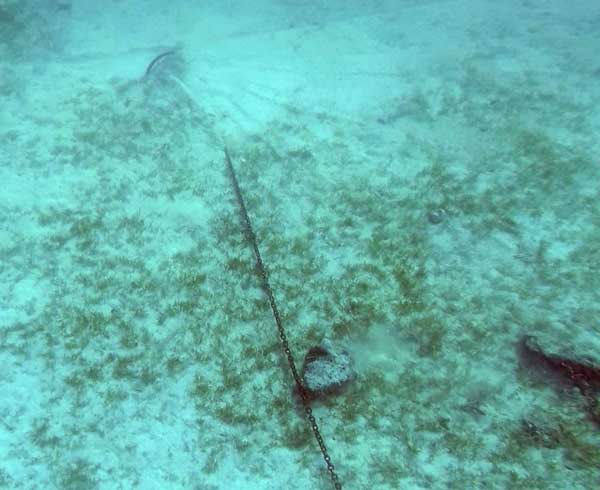
Paul dives down to take a look at it 55 feet underwater.
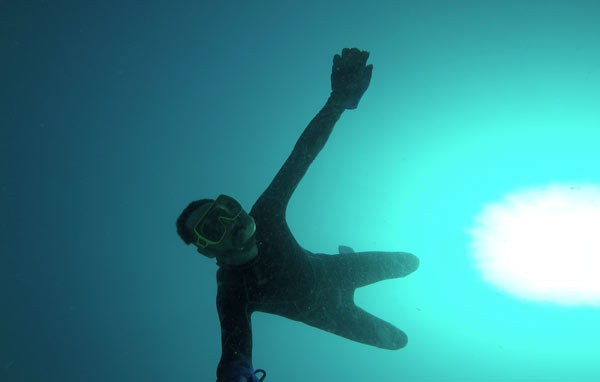
The water is nice and clear for testing here in the British Virgin Islands.
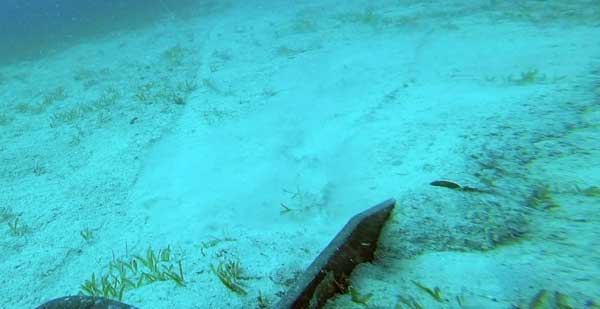
Rocna anchor set perfectly as usual... it is well buried and sitting right way up.
Cultural Differences
Anchoring is a very contentious subject and also seems to differ by culture. In North America many cruisers use a short length of chain with the rest rope. In this case the catenary method described here will not work - you need all-chain for this effect.
In the UK we rarely saw anyone anchoring with rope rode. Everyone uses all-chain rode and in many cases are anchoring in challenging crowded and tidal anchorages. Peter Nielsen of Sail Magazine comments on reducing scope with deeper water “I do agree that shallower water = greater scope. Borne out by various tests over the years. Cruising round the British coast, standard practice was 3:1 scope at HW. Often a 12-15 foot range so scope naturally increased as tide fell. “
Conclusions on Deep Water Anchoring
In normal conditions (not storm force forecast) an all chain rode will allow reduced scope in deep anchorages. We find 3:1 scope to be OK for anchoring in 50 feet of water. Increasing scope to 4:1 or 5:1 will be better and would be a good idea if strong squalls were forecast. Even an increase to 3:5:1 will make the anchor more effective (see Part 2 Crash Test here).
Additional Hints:
- It can be difficult to judge the space to your neighbours since the increased scope means you need to be further away from nearby boats. Try a range-finder app (review to follow) or a laser rangefinder example here
- Use binoculars with a rangefinder (such as our Fujinon 7X50 binos) to judge neighbourly distance.
- Use GPS and Radar to plot nearby boats.
- Ask neighbours how much rode they have out to make sure you will not hit each other.
Additional Reading on Short Scope Anchoring:
Steve Dashew - bigger anchor will allow for shorter scope if you need in deep anchorage (where you most often need it)
Go for a heavy anchor - in any given anchorage a heavier anchor will perform better than a lighter one.
Rocna designer Peter Smith discusses catenary with graphs
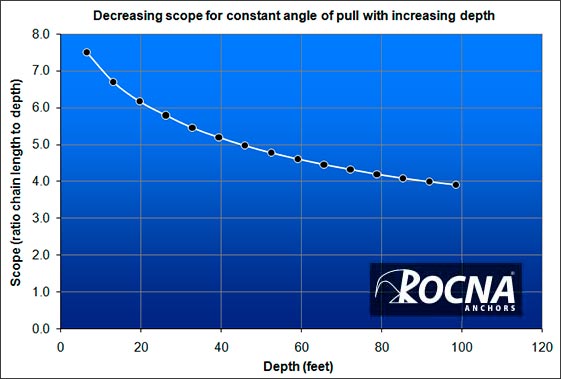
Catenary Calculator - give it a try!
Check out anchorages around the world with us aboard Distant Shores
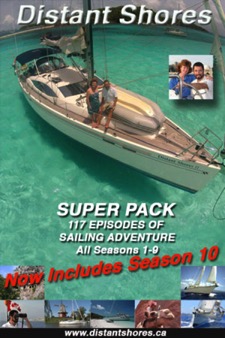
Order the Super Pack on DVD and get Season 1-10 Downloadable.
Order the Super Pack on Vimeo and we will send you the code for Season 10 as a bonus. Email us for details.
The Best Sailboat Anchor
04/10/14 15:33
What's the best anchor for a cruising sailboat?
Over the past 25 years we have used a CQR, Delta anchors and Rocnas as primary anchors, and the Fortress, Fisherman and Danforth-copy as backup-spare or storm anchors. We have anchored for many thousands of nights and have ridden out some serious gales at anchor. We have anchored throughout the Caribbean, Bahamas, USA, Mediterranean and Europe. Plus I dove down to check our anchor, and the anchors on many other sailboats over those years.
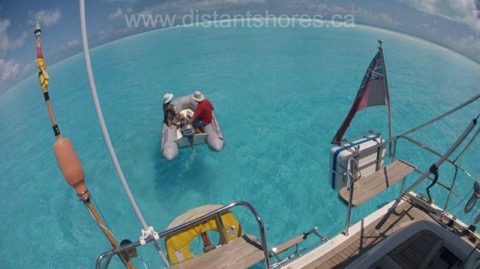
If you are planning a cruise you might well be considering a new anchor - upgrading your anchor and ground tackle for the big adventure ahead. And at the risk of summarizing our MOST important finding over the years - upsize your ground tackle if you can! A larger anchor will definitely hold your sailboat more than a smaller one of the same kind! Manufacturers seem to recommend quite small anchors for boat size but the reality of successful world cruisers out there is "bigger is better". Note this Blog is just on anchors - for details on our full anchor setup click here Ideal Anchoring Setup.
Check out this clip from Let’s Go Cruising - Anchoring on Scope
Now ... on to the anchors.
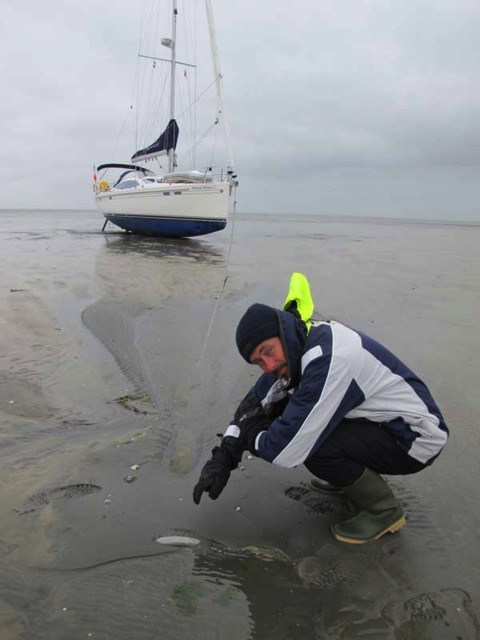
Here’s our Rocna well buried in the Wadden Sea of Holland
CQR
Our first sailboat was 37 foot long weighing about 18,000 pounds. We carried a 45 pound CQR as the primary anchor. Back in 1988 when we bought it the CQR was one of the most common anchors. Although it was upsized from the recommended 35 for our boat - we still found it was difficult to get it to set in many circumstances. We thought that was just how it was until we started diving on it and found it would mainly lie on its side and drag for quite a while before setting. We upgraded to a Delta 44 for the same boat and found it set much better.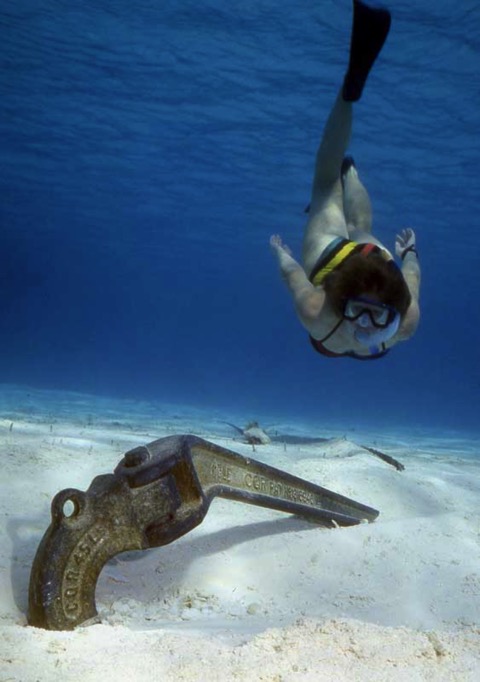
Sheryl checks out the CQR in Bahamas Sand
Delta
We used this anchor on both our 37 footer and also for a year on our 42 foot saiboat. Our Southerly 42 came with a 20kg (44lb) anchor. Why just 20kg? That was the recommended size by the manufacturer. It worked OK in the Caribbean and Bahamas but dragged a few times in the soft Chesapeake mud. I wish we had a 32kg model since that would have been more appropriate, and I would have been able to test it. Instead we switched over to test a Rocna 25kg. It would set in that same soft Chesapeake mud and also worked great everywhere else. But I still think it would have been good to try the heavier Delta. If you get one definitely upsize from the recommended one. From the tables they recommended a 16kg model for our 42. The 20 that Northshore put on will supposedly work for a 43 foot sailboat to over 50 feet. Come on guys! It is a very good anchor - great in weedy bottoms but must be upsized at least 1 model to work reliably as a primary anchor in my humble opinion!Rocna
We had a Rocna 25 (55 lbs) on our Southerly 42 and loved it. When we had the Southerly 49 sailboat built I opted for the Rocna again - this time a 33kg model (73 pounds). Our 33 model is listed on Westmarine at $879. Rocna has a very different sizing philosophy and seems to have much more realistic expectations in line with the average cruising sailor. Check out this comprehensive table from the Rocna website that builds in LOA plus displacement for improved sizing.Our 49 footer should have a 33kg or possibly the 40kg model. Very realistic. We find the Rocna sets very quickly and holds very well. It just works - and works very well. Setting in sand and regular mud it is great, and it even works well in that tricky "soupy" mud of the Chesapeake Bay. In grass it can have trouble like most anchors, but we have only dragged once - thick grass in Denmark. When we pulled it up the roll bar had clogged up with a huge ball of grass-weed and needed to be cleared before we could set it again. In those situations all anchors have difficulty. Another time where bigger is better! Perhaps the NEW Rocna with no roll bar will solve this?
Fortress
This is a special lightweight anchor excellent as a spare! It disassembles quickly and goes in its nifty bag making it perfect as a storm anchor. Made out of aluminum it is light for its holding power. We have carried them on board since 2007. Now on our 49 we have 2 models. A FX-23 (which confusingly weighs just 15lbs) plus a FX-37 which weighs 21lbs. We hung on that FX-37 in tropical storm force winds last summer and it didn't budge. Set in sand or mud the Fortress NEVER budges in our experience. A great backup anchor. We might add another larger one for storms as well. The FX-55 weighs just 32 pounds packing down in a slim bag. Here's their quite realistic Fortress sizing table. I wouldn't use the Fortress as a primary anchor since I don't think its as good in grass, and might be damaged in rocky conditions, but it seems unbeatable as the backup and secondary or storm anchor! We have used it many times and it has held perfectly. After heavy winds it is so well set that getting it up again requires the boat right overhead and winches employed!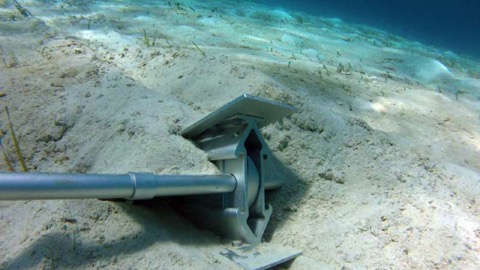
Our Fortress FX23 set in sand with light grass
Fisherman
We had a 75 pound fisherman anchor that disassembled into 3 pieces. It is actually the heaviest anchor we have ever carried. The plan was to use it as a storm anchor on our 37 footer. We carried it for 3 years fulltime cruising and never used it once. It was so heavy that the one time we tried to assemble it and get it into the dinghy to take out was very daunting. We also had a smaller 35 pound model to help anchor us in grass. We tested this but found we were never able to get it to set at all. Yikes! If you don't know what a fisherman anchor looks like it's the "standard anchor" shape - many pubs, yacht clubs, restaurants and hotels use this type of anchor in their front lawns and flower beds. Seems a good place for them :-)Danforth type
We had a Danforth-style anchor as a backup on Two-Step (our 37 footer). It worked well but was difficult to stow since it did not disassemble like the Fortress. We use only the Fortress these days.Other Interesting Anchors
Above are all anchors we have had onboard our boats and have personal experience with. But there are so many anchors out there, and some we re interested in but haven’t had a chance to test. The good old Bruce anchor was a standard sight on cruising boats back in the day. In my diving experience I would find them set quite well in the bottom. Today Lewmar Claw is similar to this. A very heavy one of these would likely be a good and affordable choice (for our 49 footer I would choose a 110lb model at $369 from West Marine). Manson makes a competitor for the Rocna but we have no experience with these anchors. Many people like the Spade anchor (nifty selector program here) which take apart for easy stowage. The Spade anchor is somewhat similar to the Rocna in shape but without a roll bar. For our boat the 30kg steel Spade is$1150. They have an aluminum version too - 15kg version for $1800 wow!
Video of Testing
We filmed anchor tests of most of our anchors and have put these in our new video program “Let’s Go Cruising - Anchoring” on Vimeo.
Summary
Getting a good night’s sleep aboard your sailboat at anchor will often depend on your anchor. Can you trust it? A good primary anchor will be a key factor. And knowing you have spare anchors to handle all conditions is also important. Our experience has shown us that the new generation anchors like the Rocna are worth the investment.
So there you are - the best anchors we have been able to find and have tested aboard our sailboats for the past 25 years.
More Info? - Click here for full information on our Ideal Anchoring Setup
I know this will be a contentious issue, so go ahead and add comments below. What anchors have you found to be the best, and what problems have you had with them? Let’s hear your experiences!

Ideal Anchor Setup
17/07/14 03:05
The ideal anchor setup for Distant Shores …
For nearly 25 years we have been cruising internationally and thousands of nights have been spent at anchor. We have had three boats (37 feet, 42 feet and 49 feet) with different anchoring setups, and we have had a variety of different anchors, both as our primary anchor and as our secondary anchors. We have anchored in the tropics, up and down the US East Coast, in the Mediterranean and in Northern Europe up to Norway's fjordland. And in many of those anchorages where the water is warm enough, I have swum down to check our anchor(s) and also others nearby so I have seen many different anchors perform in various conditions.
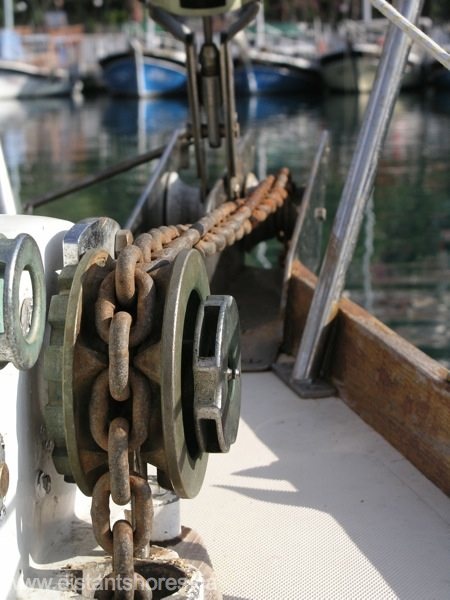
Here is the setup on our first boat, a 37-footer with a manual windlass and 40 meters of chain.
We have also seen a number of people having problems, dragging and using inadequate anchors or techniques for the anchorage.
Anchors have improved, there are more options for windlasses and other equipment has evolved over this past 25 years. Now there are fewer excuses for not having a ground tackle system that will allow the cruising sailor to anchor securely in a wide variety of situations. You can anchor confidently and get a good night’s sleep at anchor.
So here is a summary of our ideal anchor setup...
- Rocna or other newer generation anchor - We have had Rocna on our last two boats and they have been a big improvement over our old plow-style anchors. Especially the CQR which was much more difficult to set properly. For our current 49 footer, Distant Shores II, Rocna recommend a 33 or a 40kg model - we chose the 33kg (73 pounds) and it has been the most dependable anchor we’ve ever owned. (Rocna are one of the only companies I am aware of that recommend reasonable size anchors). I have read recommendations from other manufacturers for as low as 1 lb anchor weight for 1 foot of boat length. That would mean we need a 49 lb anchor for our 49 foot monohull. This is not enough in my opinion for real world cruising and secure anchoring with a good night sleep!
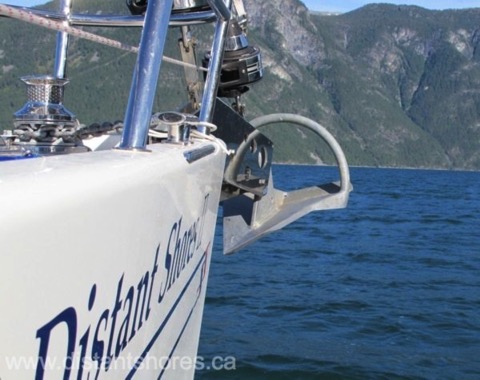
- all chain rode. We have 80 meters which is more than strictly necessary. If you needed to save weight 50 or 60 meters would be fine but more is nice especially in the Med when stern-to mooring. The 80 meters also allows us to anchor in very deep anchorages, but this would also be OK with 50 meters chain plus 30 meters rope spliced on. I recommend hi-test chain (we have used G4 but G7 is also an option if you need to reduce weight more). Definitely put the extra weight into the anchor not the chain. For example, 8mm G4 chain would save 30% of the weight of 10mm BBB chain and have similar strength. Then you can afford to upsize the anchor :-) - Note: The rode should be attached to a solid point in the anchor locker so that it will not all go overboard if you drop it all by mistake. For all chain rode this should be on a tail of rope long enough so the rope will come up on deck when the last chain is dropped. This way you can cut it easily if you need to drop the rode in an emergency.
- good windlass. You need something to pull in the chain with. Handling chain by hand can be dangerous. We have a vertical Lewmar V3 windlass which works well. We have also had horizontal windlasses on previous boats. Originally we had a robust Seatiger horizontal manual windlass which gave us 18 years of trouble-free operation. We replaced it with a Lewmar vertical windlass under the orders of the first mate who was tired of manually winching!
- good bow roller. Ideally the anchor will launch itself as you release the chain and not need to be pushed over. When you retrieve the anchor it will ideally come up (not swinging in to hit the bow) and store itself.
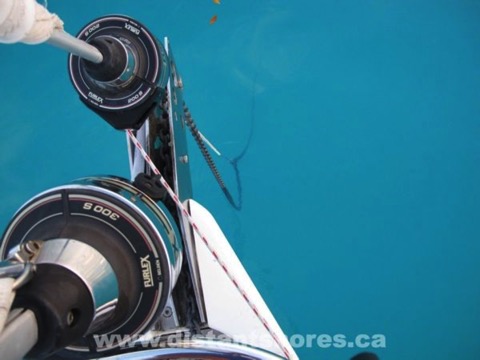
- anchor snubber - with an all-chain rode you need something to absorb the shock when the boat tugs hard and the chain straightens out. A snubber is a piece of rope that will stretch (3 strand nylon is best) with a chain hook or similar to connect to the chain. This attaches to a point on the bow so you can let out extra chain transferring all the load to the snubber. It also saves your windlass which was never meant to take strong loads of the boat at anchor. Catamarans generally use a bridle with two lines to the chain hook, and depending on your bow configuration this can also work well for a monohull.
- anchor washdown pump. I installed a saltwater pump and hose connection up forward to wash down anchor and chain as it is raised. In muddy areas such as parts of the US East Coast the anchor will need to be rinses and it is tiring with a bucket.
- anchor locker - the chain or rope-chain rode should store itself as it is raised. Sometimes chain will come up in a big pile which gets so tall it will interfere with the chain that is coming out of the windlass. Our current boat has a very deep locker so this doesn't happen even when all 80 meters of chain is brought up. On our old 37 footer the locker wasn't that tall and you could only bring up 30 meters or so before you needed to knock the pile down to make room for more chain.
- spare anchors. We carry two additional anchors - a Fortress FX23 and FX37 which conveniently disassemble and stow in a nice bag. Similarly the Spade make an anchor that can take apart for easy stowage. On our 37 footer we also carried a small additional CQR anchor but for larger boats this is not practical. A reasonable size anchor will be difficult to lift and bulky to store (unless it disassembles). If you have a larger boat it might be worth trying to accommodate 2 anchors on the bow permanently so they do not need to be manhandled. But I would still recommend oversizing the primary anchor.
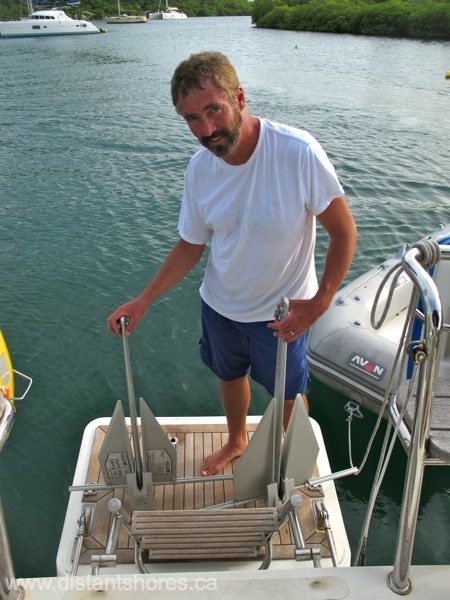
- spare rodes - we carry 4 additional rope anchor rodes. Two of them are stored nicely flaked so they will deploy easily in a bag. When I flake them carefully I can row out in the dinghy and the rope will run out of the bag without tangling making it easy for me to set the anchor myself. West Marine sell such bags and we are still using one we bought from them more than 20 years ago.
- stern anchor setup - we don't use this much but it came in handy in Scandinavia where many people will anchor and come bow in to the shore. We installed a reel with a flat anchor rode on the stern rail. Here is one of the many interesting setups we saw in the Baltic where this is common.
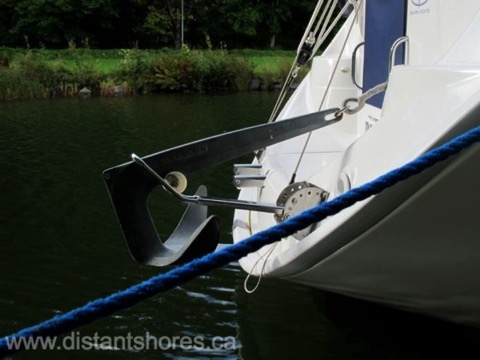
- Chain Counter - It is important to know how much chain you have out to calculate the proper scope. We tested an automatic anchor chain counter on our Southerly 42. It displayed the amount of chain on a screen at the helm and could also be used to raise and lower the anchor from the helm. It worked quite well and was especially nice to see exactly how much chain. On Distant Shores II we do not have a chain counter (I might add one) but have marked the chain in 10 meter lengths using electrical tie-wraps.
- We have an anchor alarm (see App article) to alert us if we drag or drift outside the range we have set up. Nice. You can also use a regular GPS plotter to check if you have moved but an actual alarm is better in case you sleep through a squall and the boat starts dragging.
Well there you go, our ideal anchoring setup - hopefully we have some ideas that might help you out in the quest for the perfect anchor setup so you can enjoy anchorages wherever you cruise. If you have any suggestions jump in with comments below! Post pix too!
Check out anchorages around the world with us aboard Distant Shores

Order the Super Pack on DVD and get Season 1-10 Downloadable.
Order the Super Pack on Vimeo and we will send you the code for Season 10 as a bonus. Email us for details.
Anchors stuck in the Chesapeake Mud
16/10/09 14:07
The past 2 days have been windy cold and miserable here in Annapolis. The boat show finished with great weather through the whole 5 days of the show. Now it seems like winter has set in!!! Brrr!
We are anchored in a little creek and getting a chance to test out our anchors in the soft Chesapeake Bay mud. When we were here last year we had trouble in the mud - the only time we had trouble with our Delta 44 (20kg) in the 3 years we have had one. The Delta slipped 4 times in a number of Chesapeake anchorages. I think it is a good anchor but perhaps would have to be bigger for the Southerly 42. At any rate we took the opportunity to re-evaluate anchors and decided to try out the Rocna. We got it in Moorhead City and have now sailed with it for one year, anchoring throughout the Caribbean and Bahamas. It has performed consistently well from sand to grass and some mud. Now we are back in the Chesapeake Mud that was a problem last year.
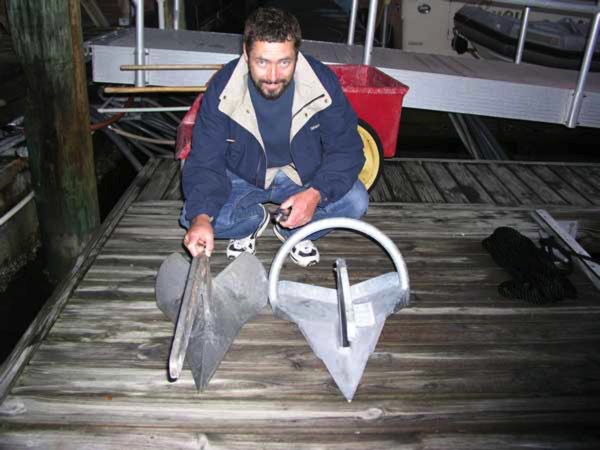
Rocna 25kg on the right - note scoop shape and large surface area.
So how did it do? The short answer is ... Excellent!
First of all, the Rocna is a 25kg anchor so it’s heavier than the Delta we replaced. I very much admire Rocna for standing up and saying they recommend a heavier anchor. The Rocna people have actually sailed and anchored and know you need a serious dependable anchor on the bow of a cruising boat. Most other anchors seem to recommend smaller lighter anchors but in small print they say it is for winds up to 25-30 knots - basically a day anchor/lunch hook. I think our anchor is probably our most important insurance!
I can’t say why exactly but the Rocna seems to have conquered the gooey Bay Mud. It has never slipped here as we have tested it in a few anchorages. The toughest test we have tried is anchoring stern to a dock. In this case the Delta had slipped repeatedly. Now in exactly the same place the Rocna has been great. Once set in, it has held many times the force we achieved last year. Overall this is the best anchor we have tried and are happy to be putting one on the new Southerly 49. We are moving up to a 33kg (73 pound) version.
Here’s a shot of the Rocna 25 on our Southerly 42 in the Bahamas this past spring.
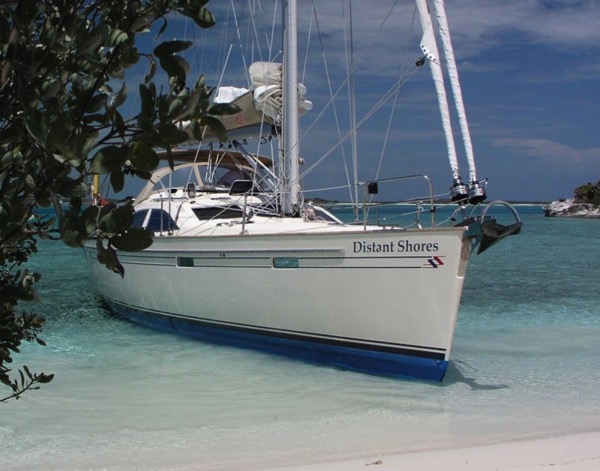

Join our email list and get hints, technical articles and tips plus videos to help you achieve your cruising dreams.
We are anchored in a little creek and getting a chance to test out our anchors in the soft Chesapeake Bay mud. When we were here last year we had trouble in the mud - the only time we had trouble with our Delta 44 (20kg) in the 3 years we have had one. The Delta slipped 4 times in a number of Chesapeake anchorages. I think it is a good anchor but perhaps would have to be bigger for the Southerly 42. At any rate we took the opportunity to re-evaluate anchors and decided to try out the Rocna. We got it in Moorhead City and have now sailed with it for one year, anchoring throughout the Caribbean and Bahamas. It has performed consistently well from sand to grass and some mud. Now we are back in the Chesapeake Mud that was a problem last year.

Rocna 25kg on the right - note scoop shape and large surface area.
So how did it do? The short answer is ... Excellent!
First of all, the Rocna is a 25kg anchor so it’s heavier than the Delta we replaced. I very much admire Rocna for standing up and saying they recommend a heavier anchor. The Rocna people have actually sailed and anchored and know you need a serious dependable anchor on the bow of a cruising boat. Most other anchors seem to recommend smaller lighter anchors but in small print they say it is for winds up to 25-30 knots - basically a day anchor/lunch hook. I think our anchor is probably our most important insurance!
I can’t say why exactly but the Rocna seems to have conquered the gooey Bay Mud. It has never slipped here as we have tested it in a few anchorages. The toughest test we have tried is anchoring stern to a dock. In this case the Delta had slipped repeatedly. Now in exactly the same place the Rocna has been great. Once set in, it has held many times the force we achieved last year. Overall this is the best anchor we have tried and are happy to be putting one on the new Southerly 49. We are moving up to a 33kg (73 pound) version.
Here’s a shot of the Rocna 25 on our Southerly 42 in the Bahamas this past spring.


Join our email list and get hints, technical articles and tips plus videos to help you achieve your cruising dreams.
- FREE 1/2 hour video on cruising the Exuma Islands in the Bahamas
- Technical Blog shows you how to deal with issues facing the cruising sailor
- Destination information from some of the world's best cruising areas
- Special discounts and promotions